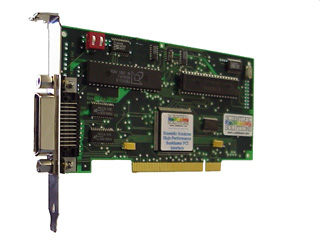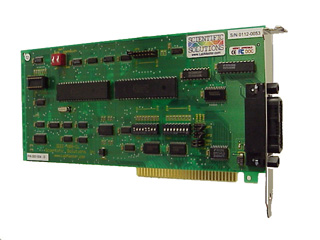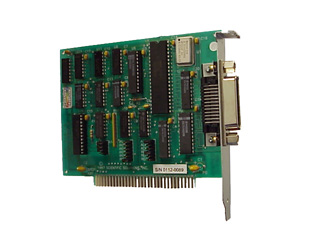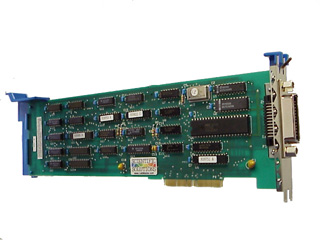
Scientific Solutions ® Inc.
IEEE 488 GPIB Family of Products
| Product Description |
Scientific Solutions' IEEE 488 GPIB cards plug directly into one slot of your personal computer and gives your computer complete access to the IEEE 488 General Purpose Interface Bus (GPIB). Scientific Solutions offers four models.
|
 Product Description
Product Description
The Scientific Solutions IEEE 488 GPIB Interfaces are I/O expansion cards that plug directly into one slot of your PC. Each card gives your computer complete access to the IEEE 488 General Purpose Interface Bus (GPIB). With access to the GPIB, your PC can act as system CONTROLLER, or as an addressed TALKER/LISTENER.
As CONTROLLER, the IEEE 488 cards can issue commands with both primary and secondary addressing. The IEEE488-CL (PCI and ISA) supports our original IEEE register set. The IEEE488-LM and MC-IEEE488 each support the NI PCII/PCIIA register set. Specific software may require a particular register set. Software such as Scientific Solutions' ROUTE488 will work with any of the IEEE 488 cards and will greatly help in creating custom GPIB applications.
The IEEE 488 cards come with support software which offers test routines and example programming to help with the development of customized setups. Scientific Solutions also has available ROUTE488 software, which is a memory resident driver written in assembly language designed to optimize communication with the GPIB interface.
ROUTE488 makes custom GPIB programming fast, easy and offers support for many programming languages.
 Our Solution Includes:
Our Solution Includes:
- High speed GPIB interface for your PCI, ISA or MicroChannel based PC
- IEEE488 Support Software
- Test Software
- Menu-Driven IEEE Control Software
- DOS printer/plotter support software
- Handbook
- RF double shielded 2 meter cable (optional accessory)
 Key Features
Key Features
- Provides full implementation of The IEEE 488-1978 GPIB Bus Standard
- Family of cards offer various register sets to support specific software requirements
- As CONTROLLER, the IEEE 488 cards can issue commands with both primary and secondary addressing.
- DMA controlled data transfers provide high speed operation
- DMA and interrupt lines can be software disconnected, allowing other devices to share them.
- Can support service request parallel and serial polls, device clear, device trigger, and remote/local functions.
- Any of 10,000 different instruments can be connected to your PC via the IEEE 488 Interface.
- Easy to install, plugs directly into one slot of your Personal Computer.
- Provides all TALKER/LISTENER functions.
- Provides all CONTROLLER functions.
- Offers complete source and acceptor handshake.
- Provides extended addressing capability.
- Supports interrupt-driven or Polled operation.
- Allows automatic handling of addressing and handshake protocol.
- Offers EOS and EOI message termination.
- Allows complete implementation of transfer control protocol.
- Offers full buffering of all bus I/O.
- Included software transfers byte, string, or title information.
 Applications
Applications
The IEEE488 Interface has a multitude of communications applications in scientific and industrial environments. Some of the most common of these include:
- Data acquisition and process control
- Analysis of biological, chemical, and physical processes
- Industrial and laboratory data collections and control routines
- Laboratory automation
- Chemical testing and analysis
- Data acquisition subsystems
- Robot samplers
- Mass spectrometers
- Gas chromatography
- Scales and Measurements
- Automatic test systems
- Quality control Monitoring
- Automatic Test bench
- Individual instrumentation workstations
- Multimeters
- Digitizing Oscilloscopes
- Signal generators
 Functional Description
Functional Description
- The Scientific Solutions IEEE 488 cards implements the GPIB IEEE-488 standard.
- The IEEE 488 installs inside your PC.
- An IEEE standard cable attaches to a shielded IEEE488 standard D-shell connector on the card. The other end of the cable attaches to your GPIB peripheral (plotter, instrumentation, controller, etc.).
- Programmed I/O can transfer data between the IEEE 488 card and the computer. Direct Memory Access (DMA) circuitry allows faster transfer of data.
- An on-board oscillator guarantees accurate, high speed GPIB timing. Actual transfer rates depend on the DMA speed of the computer and the slowest GPIB Listener.
- Hardware interrupts (IRQ) are possible for sources such as data received, data send, END message received, service request, etc.
- For application developers, Scientific Solutions recommends ROUTE488 software. Using this software, you can get high-speed data transfers on the GPIB without having to provide your own customized assembly language programming.
- The IEEE488 cards have selectable I/O address, DMA channel and IRQ. Using the IEEE 488 standard protocols, the IEEE 488 Interface can connect your computer to over 10,000 different types of instruments, supporting up to 15 simultaneously.
- Multiple IEEE 488 cards can be put into a single PC to support more simultaneous instruments.
 Technical Specifications
Technical Specifications
| IEEE488-CL/PCI | IEEE488-CL/ISA | IEEE488-LM | MC-IEEE488 | |
|---|---|---|---|---|
| Operating Temperature | 0º to 70º Celsius | 0º to 70º Celsius | 0º to 70º Celsius | 0º to 70º Celsius |
| Storage Temperature | -50ºC to +150ºC | -50ºC to +150ºC | -50ºC to +150ºC | -50ºC to +150ºC |
| Relative Humidity | 95% non-condensing | 95% non-condensing | 95% non-condensing | 95% non-condensing |
| Hardware Interrupts | PCI Plug-and-Play | IRQ 2- 7 | IRQ 2- 7 | MCA POS IRQ 2-9 |
| Power: +5 Volts | 450mA typical | 500mA typical | 585mA typical | 585mA typical |
| Load | 1 TTL | 1 TTL | 1 TTL | 1 TTL |
| DMA | PCI Target Only | ISA DMA 1, 2 or 3 | ISA DMA 1, 2 or 3 | MCA POS DMA 0 to 15 |
| Slots | PCI short | ISA 3/4 | ISA 1/2 | MicroChannel |
| Address | PCI Plug-and-Play | Any using A0-A9 | 16 jumper select | MCA POS 8 selections |
| Agency Approvals | FCC- Class A, CE-Mark | FCC- Class A, CE-Mark | FCC- Class B, CE-Mark | FCC- Class A, CE-Mark |
 Frequently Asked Questions
Frequently Asked Questions
Q1. Can I use the IEEE-488-CL/PCI as a direct replacement for the IEEE-488-CL/ISA?
A1. YES. The IEEE-488-CL/PCI was designed to be a direct replacement for the ISA version. Software originally written for the ISA card will run on the PCI card without any modification. As an example, customers using our IEEE-488-CL/ISA card with Varian Chromatography systems have used the IEEE-488-CL/PCI with their existing software - allowing them to upgrade their computer system without costly new software.
Q2. The IEEE cards are shipped with an application called IEMENU.EXE. How can you use IEMENU to test the IEEE card?
A2. IEMENU.EXE is a program that can be used to verify that the card is communicating to your other equipment. It is not really "test" code, but is to serve as a quick program to try things. For IEMENU to work, you need to connect the IEEE-488 card to another IEEE device. In this example we used a multimeter. IEMENU will work under DOS or a DOS session of Win3x, Win95, Win98 or WinMe. It will not work under WinNT, 2000 or XP.
You need to know the IEEE-488 "id" of the other equipment. IEMENU assigns the ID=29 for the IEEE-488/CL card. As previously mentioned, IEMENU requires that the IEEE card have another device connected to it.
Here is an example of using IEMENU.EXE with Scientific Solutions IEEE-488 card. For this example, we have a FLUKE-45 multimeter attached as the IEEE-488 device. We have the meter set for ID=5.
The following example is using a FLUKE-45 multimeter that has been configured for a GPIB ID=5. For this example, we first set the IEEE-488 as the talker (ID=29) and the FLUKE-45 (ID=5) as the listener. We then WRITE the command *IDN? to the FLUKE-45 which is a specific command for this particular meter that is asking for information. We then set the FLUKE-45 as the talker and the IEEE-488 card as the listener. Lastly, we then READ the information from the FLUKE-45.
If you try a similar test with your equipment you need to know what the GPIB address is of the equipment. Also you will need to know what command you can send to your instrument (Write) that will make the instrument respond with data that you can Read.
For the following steps "CR" is a carriage return (Enter key)
(1). Connect 488 cable from the IEEE-488/CL card to the other equipment
(2). Power up the computer and equipment
(3). From a DOS prompt, type IEMENU
(4). Logo screen appears "Press Any Key to Continue"
(5). Main Menu
(6). F1 - Read/Write Function
(7). Read/Write Menu
(8). F1 - Set Talker
(9). GPIB Talker Address? 29 "CR"
(10). Secondary Address? "CR"
(11). Read/Write Menu
(12). F2 - Set Listener
(13). GPIB Listener Address? 5 "CR"
(14). Secondary Address "CR"
(15). GPIB Listener Address? "CR"
(16). Read/Write Menu
(17). F6 - Write String
(18). String = *IDN?
(19). Read/Write Menu
(20). F1 - Set Talker
(21). GPIB Talker Address? 5 "CR"
(22). Secondary Address? "CR"
(23). Read/Write Menu
(24). F2 - Set Listener
(25). GPIB Listener Address? 29 "CR"
(26). Secondary Address "CR"
(27). GPIB Listener Address? "CR"
(28). Read/Write Menu
(29). F4 - Read String
(30). FLUKE-45 SN:021254 (this is specific information returned by our meter)..
Specifications subject to change without notice.
Scientific Solutions liability, trademarks, and export notices apply.
Copyright © 1972-2025 Scientific Solutions - All rights reserved.



